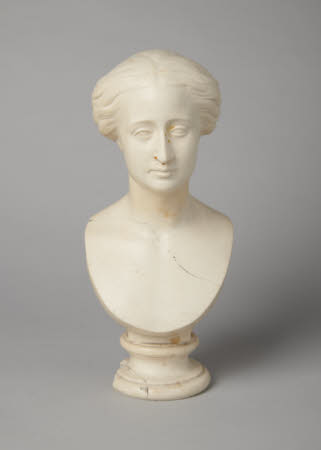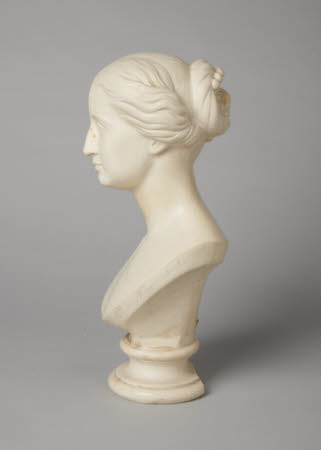Portrait bust of the Empress Eugénie (1826-1920), consort of Napoleon III, Emperor of France
after Count Alfred Émilien O'Hara van Nieuwerkerke (Paris 1811 - Gattaiola 1892)
Category
Art / Sculpture
Date
1852
Materials
Plaster
Measurements
355 x 140 x 127 mm
Place of origin
Paris
Order this imageCollection
Mount Stewart, County Down
NT 1220137
Summary
Sculpture, plaster; Portrait bust of the Empress Eugénie; Émilien de Nieuwerkerke (1811-1892); 1852. A portrait bust of Eugénie de Montijo, countess of Teba (1826-1920), made in 1852, just before her marriage to Emperor Napoleon III on 29 January 1853. The sculpture, published by Susse Frères, was the first official portrait of the new empress.
Full description
A portrait bust of Eugénie de Montijo, countess of Teba (1826-1920), showing the sitter facing forward, her hair gathered up at the back of her head into a coil, held in place with a pearl clasp. On a round socle. Signed on the left shoulder by the sculptor, Émilien de Nieuwerkerke (1811-1892). It is a pair to a bust of Eugénie’s husband the Emperor Napoleon III (NT 1220126). The bust is damaged, with sections of the base at right and back missing. A crack extends from the right shoulder, through the neck and down through the left shoulder, continuing around the back. The Empress Eugénie was born in Granada in Spain on 28 May 1826, the daughter of a Spanish nobleman Don Cipriano Palafox de Guzmán y Portocarrero, count of Teba (1786–1839) and from 1834 count of Montijo, and his wife Maria Manuela Enriqueta, née Kirkpatrick (b. 1794), whose ancestry was Scottish. Eugénie spent part of her youth in Paris, where she was educated. On a visit to the city in 1852, she was introduced to Louis Napoleon Bonaparte, Napoleon III (1808–1873), emperor of the French from 1851, who fell madly in love with her, seeing in her something of Joséphine, the first wife of his uncle, Napoléon I. Despite the opposition of his family, Napoleon married Eugénie on 29 January 1853. Eugénie was not heavily involved in her husband’s political life until towards the end of his reign, except for occasions when she acted as regent. She was instead known for her devotion to charitable causes, her taste for expensive clothes and furnishings and her insatiable appetite for social events and entertaining. It was in great part thanks to Eugénie that the Second Empire came to be marked by seemingly endless extravagant court entertainments in the Tuileries palace in Paris and in other residences such as the château de Compiègne. With the collapse of the Second Empire, following France’s humiliating defeat in the Franco-Prussian war in 1870, Eugénie fled to Britain, where she found a warm welcome from her close friend Queen Victoria. She was subsequently joined by her husband in exile, the couple setting up a court in exile in Chislehurst. After the death of Napoleon III in 1873 and the death in 1879 in the Anglo-Zulu War of their only son the prince imperial, who had joined the British army, Eugénie made a new home in Farnborough, where she founded a Benedictine monastery to house a mausoleum for her husband and sons’ tombs, as well, eventually, as her own. The sculptor of the busts of Napoleon and Eugénie, Alfred Émilien O’Hara, comte de Nieuwerkerke, was an emblematic figure of the Second Empire and a close friend of the emperor and his wife. From a minor aristocratic family of Dutch origins, Nieuwerkerke was born and grew up in Paris and began to become known as a sculptor in the 1830s. He became the lover and companion of Princesse Mathilde Bonaparte (1820-1904), the cousin of Napoleon III, and thus quickly became a powerful figure in the circle of the Emperor’s advisers. He was appointed Napoleon’s Surintendent des Beaux-Arts (Director-General of the Fine Arts) and Director of the Musée du Louvre. Nieuwerkerke also fled France after the collapse of the Second Empire, coming first to England, before settling in Italy. His extensive private collection of armour and works of art was bought by Sir Richard Wallace and today forms part of the Wallace Collection. The busts of Napoleon III and the Empress Eugénie were published by the French sculpture foundry Susse frères, and were illustrated in the company’s 1860 catalogue, available in casts in bronze or plaster. Portraits of the emperor were offered depicting him in his official uniform or as a plain bust mounted on a herm or a socle, the form of the portrait at Mount Stewart. Whereas the busts of the emperor were offered in two sizes, those of the Empress seem only to have been made in the one size. The small bronze busts of the emperor sold for 75 francs, whilst the plaster versions were very much more inexpensive, just 8 francs. Jeremy Warren April 2022
Provenance
On loan since 1976 to the National Trust from Lady Mairi Bury (1921-2009). Purchased in 2012 by the National Trust, from the Estate of Lady Mairi Bury.
Marks and inscriptions
On side of left shoulder:: Cte de Nieuwerkerke
Makers and roles
after Count Alfred Émilien O'Hara van Nieuwerkerke (Paris 1811 - Gattaiola 1892), sculptor Susse Freres Bronze Foundry (founded 1758), founder
References
Cadet 1992: Pierre Cadet, Susse Frères. 150 Years of Sculpture, Paris 1992, pp. 128 and 151. Maison 2000: Françoise Maison, ed., Le comte de Nieuwerkerke. Art et pouvoir sous Napoléon III, exh. cat., Château de Compiègne, Paris 2000, p. 171, no. 120.







